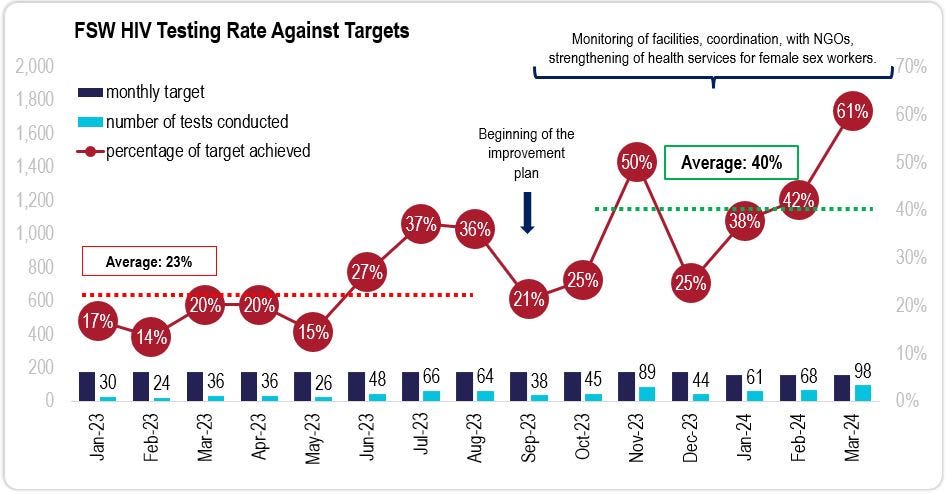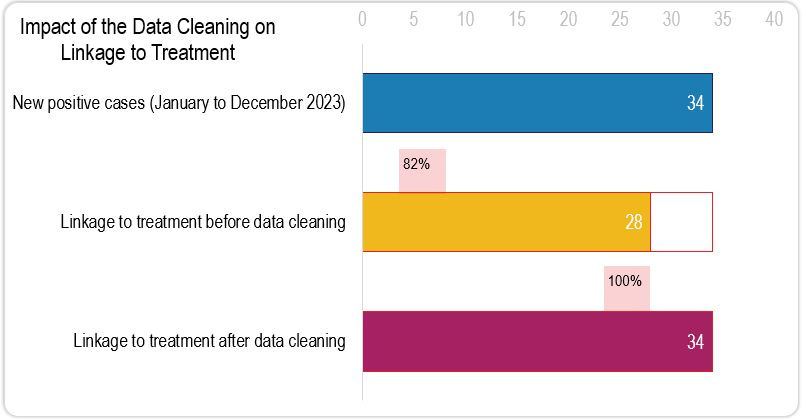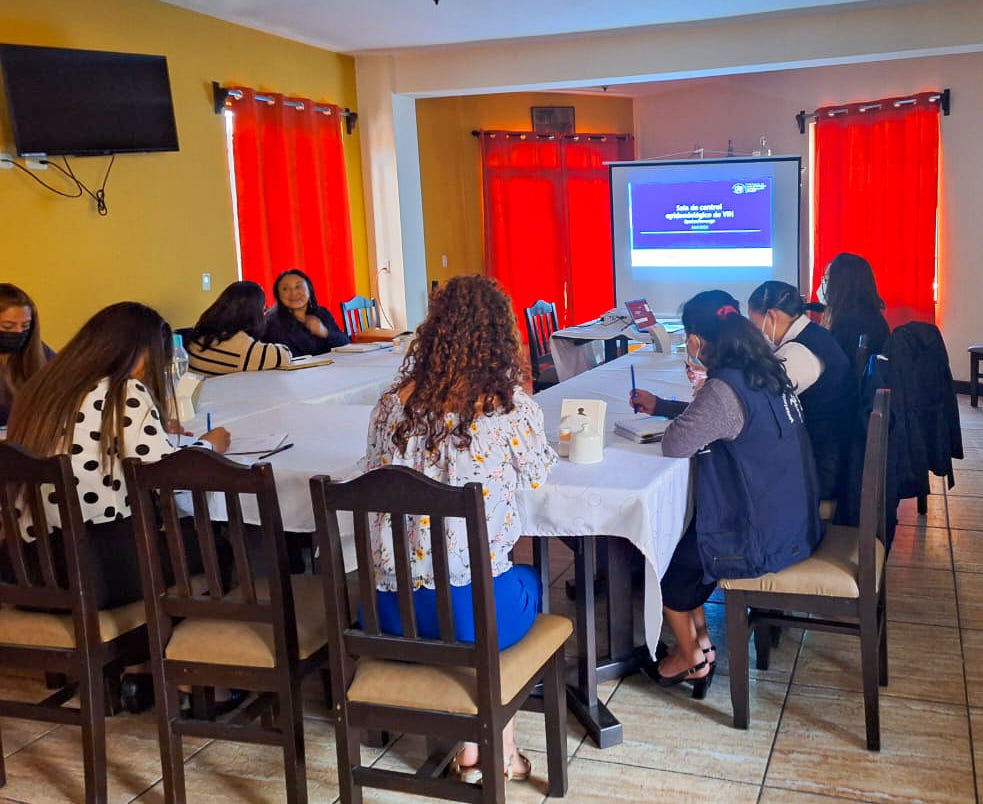Starting Simple, Going Big: How a Thriving Data Use Community Is Sustaining Health Progress in Quetzaltenango, Guatemala
By Dora García (Data.FI/Guatemala Data Use Advisor)

Introduction
The Quetzaltenango health area, situated in the western portion of Guatemala, has around 950,000 residents. [1] The land is dominated by mountainous highlands and wide valleys, and the indigenous K'iche' and Mam populations predominate in this region.
The health area has three hospitals: 1) Coatepeque Hospital, 2) Quetzaltenango Regional Hospital, and 3) Rodolfo Robles Hospital, each of which houses an Integral Care Unit (Unidad de Atención Integral, or UAI) specifically designed to provide care for HIV patients. In addition, there is a network of health services that operate through health posts and centers.
For years, Quetzaltenango health officials made use of technical teams to analyze health data. For HIV specifically, the teams relied on a set of basic indicators, including the number of condoms distributed and tests carried out at the community-level. But despite being highly motivated, these health officials lacked a standardized methodology to monitor (and eventually achieve) the targets they had identified.
To fill this methodological gap and build other organizational capacities in data use, they reached out to the United States Agency for International Development (USAID)-funded Data for Implementation (Data.FI) project in March 2023. Data.FI was already supporting the national government with an HIV dashboard and had previously collaborated with other local health area teams.
This new collaboration began with the establishment of a new Technical Working Group (TWG), which was comprised of the Quetzaltenango health director, the local HIV program coordinator, a statistics official, service provision staff, promotion experts, hospital epidemiologists, and coordinators of comprehensive care units. Their objective was to develop and adopt a new methodology and innovative digital tools for HIV data analysis that would allow them to analyze and monitor prioritized indicators of the HIV continuum of care.
Building a Methodology
As a first step, the TWG was trained on the data use strategy Data.FI had helped to develop through an induction workshop. They learned how best to prepare data visualizations, how to use a planning and monitoring tool, how to document successful data use cases, and how to use the prototype national HIV dashboard.
Following this capacity-building process, the TWG held monthly ‘situation room’ meetings to review the latest data and to specifically analyze a new suite of HIV care continuum indicators. Furthermore, monthly progress toward the UNAIDS 95-95-95 goals [2] began to be monitored in earnest.

This new institutionalized approach, centered around a team dedicated to regular epidemiological data review, has produced some stunning results across the HIV care cascade.
From March 2023 to June 2024, Quetzaltenango health personnel, using the methodology proposed by Data.FI to analyze information, plan and monitor indicators, and collaborate with USAID and Centers for Disease Control & Prevention implementing partners (IPs), have managed to:
Improve the referral strategy for newly positive HIV cases, which went from a median of 88% to 100% (March 23 to July 2024). This achievement was possible due to the TWG’s close collaboration with health counselors, who accompany people with a positive diagnosis from health facilities and local centers to the UAI. By focusing on referral early on and directly involving staff that were in direct contact with those with HIV+ results, the health area has connected people with antiretroviral treatment quickly.
Improve HIV screening for men in priority districts, which went from a median of 35% to 154%. This was possible because the prioritized facilities worked to improve the promotion of testing among the population (previously, HIV tests were offered almost exclusively to pregnant women, but now they are offered to men as well), extended the hours during which testing was available, raised awareness through comprehensive health days, [3] coordinated with more facilities to offer tests, and promoted the use of native languages at the facilities and in health information documents.
Increase the HIV testing rate among female sex workers (FSW). Part of a specific initiative within the broader data use efforts, the monthly average rate against targets rose from 23% (in September 2023) to 40% (as of July 2024). This remarkable progress was encouraging, and in March alone the testing rate against targets was 61%, a 40% increase since September!
Identify university students as the most at-risk population and respond accordingly. Data analyses conducted by the TWG indicated that most new HIV cases originated within the young university population. In response, the TWG reactivated work with the university committee [4] that had fallen dormant. Through this committee, voluntary testing for university students was offered, and IP-supported training and internships are being organized to expand testing provided through UAIs.
Improving data cleaning to obtain the data for the linkage indicator. In Quetzaltenango there are two main sources of information on linkage to HIV treatment, meaning that data need to be compared to ensure there are no discrepancies or inconsistencies. After a full analysis of both data sources, Data.FI has begun a data cleaning process to identify and resolve these differences. While still ongoing, this is already leaving health officials with a more accurate and unified set of information, which in turn helps connect more people to treatment (Figure 2).
Currently, the monthly situation room meetings gather between five and six local epidemiologists who lead local HIV surveillance efforts, and representatives from the Guatemalan Social Security Institute participate. The TWG also holds separate monthly situation room meetings with different groups that support and contribute to the sustainability of the HIV data use strategy in Quetzaltenango, including the group of counselors of the National STI/HIV Program that serve Quetzaltenango’s 24 health districts, the inter-university HIV Roundtable, and the HIV network of civil society organizations.
In this way, an initial data use nucleus has spawned offshoots and sub-teams that promote a thriving data use community in Quetzaltenango conducting widespread epidemiological surveillance.
Looking Ahead
The Quetzaltenango health area is one of eight in Guatemala (out of 29) that has institutionalized a data use methodology centered around a dedicated TWG and regular situation room meetings. Fully locally led and already showing signs of adaptability and sustainability, the health area can now analyze and use HIV data on its own, as the Data.FI project refocuses its efforts on other regions of the country.
In addition, this case study reveals the building blocks for a sustainable model of capacity building in action and a strategy that promotes a culture of data use.
As national and local governments across Central and Latin America try to close HIV gaps, improve their health information systems, and achieve sustainable epidemic control, Quetzaltenango offers certain lessons that are ripe for replication.
From the start, the principal decision making and implementing body was staffed and led by local health officials–with Data.FI serving an advisory and backstop role, the TWG could exercise its leadership, learn from mistakes, and build confidence, enabling a transition into a fully independent role.
Furthermore, by focusing on low-tech solutions and fostering a culture of data use, achievements have become part of institutional memory and are relatively immune to changing software requirements or external funding.
Lastly, since efforts have focused on analyzing and using programmatic and epidemiological information, the approach is scalable and adaptable to an evolving array of disaggregations and health indicators. Starting simple, Quetzaltenango has since conducted analyses disaggregated by men, women, pregnant women, trans women, men who have sex with men, female sex workers, and people in prison and other closed settings.
All of this has led to positive changes across a wide spectrum of Guatemalan society, and directly feeds into USAID and U.S. Government goals aimed at promoting and achieving more equitable health outcomes in the countries where we work.
[1] Based on the 2024 projections published by the National Institute of Statistics.
[2] Goals set by the Joint United Nations Programme on HIV/AIDS (UNAIDS) to achieve the following global targets by 2025: 95% of all people living with HIV know their status; 95% of all who know their status are connected with treatment; and 95% of all those connected to treatment experience viral load suppression.
[3] A comprehensive health day is a special one-day event that is carried out outside of health facilities. During this day, health officials offer comprehensive health information, follow-up checks for pregnant women, pediatric consultations, and free HIV tests.
[4] The following universities participate: the University of San Carlos, Rafael Landívar, Mariano Gálvez, Galileo, Mesoamericana, de Occidente, Da Vinci, Panamericana, and the National School of Nursing.




